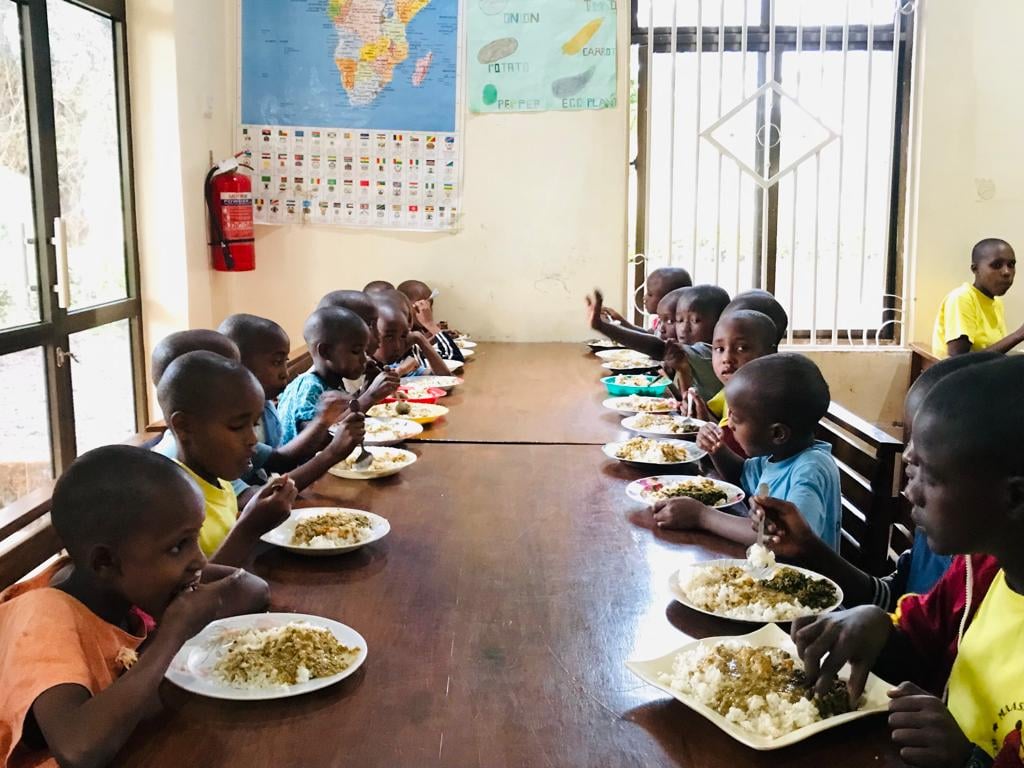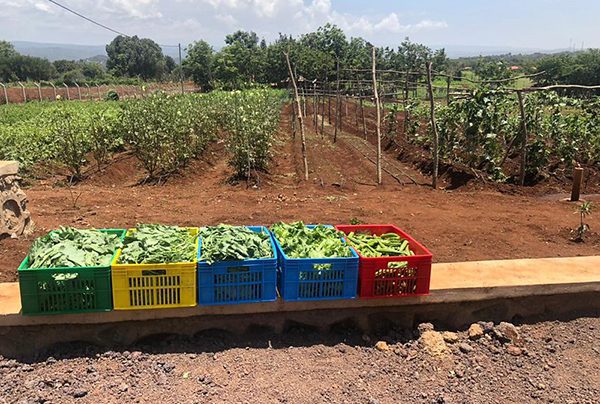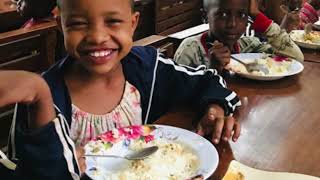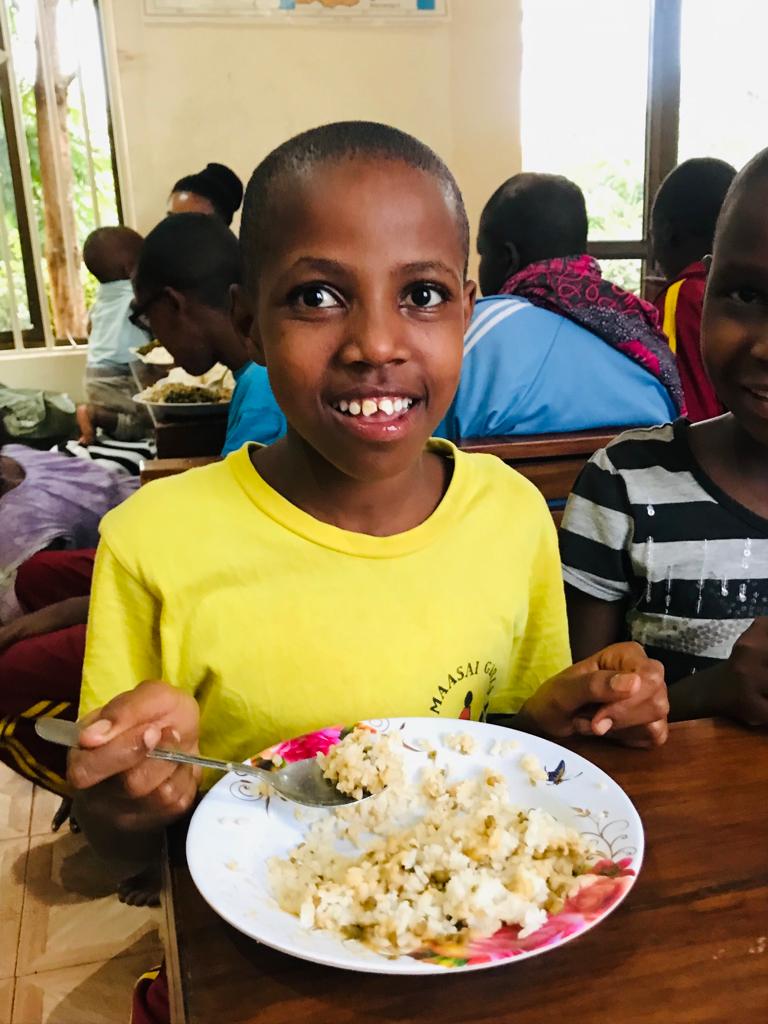This month we are celebrating the one-year anniversary of our ecoFarm. A three-acre parcel that grew from undeveloped land to lush crops, a livestock barn and a bio-gas fuel source capable of sustaining 70 people.
Proof of the difference that fresh vegetables, fruit and protein can make for a human being is evident in the health of our girls.


Their bodies are strong and full. Their faces have filled out and their eyes shine bright. Many have sprouted up in height. Their favorite food is any type of meat cooked with tomatoes and vegetables. Spaghetti and meat sauce is popular! So are omelets and burgers.
Before the girls came to MGRC, their diet consisted of black tea in the morning, with porridge maybe twice a week and beans a couple times a month. They came to us starving, some near death. Since the advent of the farm, their nutrition has improved dramatically.
The farm was the first phase of constructing our ecoVillage. The farm project began in March 2021 with clearing the land. Over the past 12 months we’ve developed crops; a barn for livestock – cows, chickens, rabbits and pigs; a hydroponic fodder system for the livestock; and a bio-gas fuel system that supplies all the farm’s energy needs.
The effort has paid off in dollars as well as improved health and nutrition for the girls.





We figured our one-time investment of $96,000 has produced food worth $37,000 in one year. We will recoup our investment in about two years. This return meets our goal to become a self-sustaining operation.
We’ve overcome challenges along the way. Water is supplied through a drip irrigation system. The hydroponic system for growing high-protein fodder for the animals was a game changer that cut costs on feed. Finding an educated, experienced local farm manager through the nonprofit East Africa Impact Center known as ECHO was a blessing. The bio-gas system reduced the need to buy fuel.
We are more than halfway where we want to be. The next improvements will help us achieve consistent production at continued reduced cost.
We would like to develop aquaponic systems for growing crops. Like hydroponics, aquaponics grows crops without the use of soil and produces higher yields than soil-grown crops. But aquaponics utilizes fish tanks.
Figuring out how to plant, when to plant, and how to preserve fruits and vegetables for later consumption also are ongoing challenges.
We would love to talk with anyone who shares our enthusiasm for modern farming technologies. Get in touch with us!


Comments(4)-
-
-
-
-
Celebrating the success of our first two graduates
-
Help us build bathrooms and classrooms
-
God’s Invisible Hand at Work
-
2023 Year in Review, Part Two: Education and Development
-
2023 Year in Review Part One: Our New Home


Daniel James Martineau says
June 14, 2022 at 3:10 pmFinally, what happens to the girls once they finish the equivalent of High School? The short answer is we don’t really know yet as we have only been doing this for 5 years and the oldest girls are still with us. The longer answer is that they can truly do whatever they want – by the time they leave us, they will be educated (which girls in the bush generally are not), and they will be past the ages when early marriage and FGM are a threat. They will be capable of caring for themselves and others as we teach trades, and they will have English proficiency, which will make them very valuable in the Tourist economy (which is a large part of the local economy). So they could go on to higher education, or get a job supporting themselves, or chose to marry and have children as is their traditional role – but with the difference that marriage and children will be their choice, and not that of their parents. We often bring in professional women from the big cities to talk to the girls – such as lawyers, doctors, teachers, government officials, etc. so that the girls learn that they can do all of these things – and more. Honestly, we can’t wait to see what the future holds for our girls, but we know it will be special! Stay tuned:)
Daniel James Martineau says
June 14, 2022 at 2:58 pmDear Joseph, I want to address your other questions as well. First, we are sensitive to the fact that Maasai culture is very different from ours in many ways. I won’t go into all of them here, but suffice it to say that we are saving these girls from circumstances that we consider unacceptable, but which may be considered normal in some villages/members. As just one example, we have a girl who suffers from Albinism – in fact there are many albinos born in the Maasai-lands and no one seems to know why. Traditional Maasai culture understands this condition as a curse or bad omen, and such babies are killed outright or placed outside of the Boma to starve or be eaten by wild animals. This is of course illegal today, but the tribal villages are often far from police jurisdictions and these kinds of things can occur with impunity. In our girl’s case, a family member saved her and brought her to us, and we determined that sadly, she could not be returned to her biological family. She has now been living with us for some years and her family is our community – the other girls, the Matrons who we employ to care for the girls when they are not in school, and the administration and staff – including Papa Rick:). She has learned that her condition does not mean that she is evil or bad luck to anybody, and in our family, she is a child of God – a unique and precious child who is loved and nurtured to grow up as “good luck” to all of us!
Joseph Vidmar says
April 20, 2022 at 9:03 pmYou are doing an outstanding job for these young girls. Just curious, do these girls have a parent(s)? Is their “family” the other girls? What is the next step in life for these young girls as they grow up?
Dan Martineau says
June 14, 2022 at 2:37 pmHI Joseph, I am sorry no-one has replied to your question yet. I am Board member of MGRC and will be happy to try to give you a sense of what kind of environment MGRC is working in.
First, MGRC is not an orphanage in the traditional sense. It is often the case that family members of a girl will show up at the Center and try to give us a girl. This could be because the girl’s parents are dead, but it could also be because they can no longer afford to feed her, or she is sick and they can’t afford to treat her, or she is threatened with early marriage or FGM (both of which are illegal but still practiced in the bush). We get numerous cases of families just trying to drop their kids off to give them a better life, but we cannot take those cases; we have strict intake policies that limit admissions to those who are in immediate danger of death or some form of severe abuse. We have a professional social services worker on staff, who conducts the interviews and collects the pertinent information. If her circumstances meet our criteria, then we contact the local government Social Services Department and they too do a thorough investigation. Then the government makes the decision of whether to remove the girl from her village and transfer her to us. As you can imagine, this is a heartbreaking process, and we turn away far more girls than we can take. But our mission is to only those girls who do not have hope of a future without us. In fact, we often take in girls on a temporary basis – if for instance they need medical care, we will drive them to hospital and pay for their care, or they need protection from abuse by a family or tribe member – and then we return the girls to their villages if we are certain they will be safe there. Hope this helps give you a sense of our processes. Please reach out again if you have any follow-up questions or comments!
Recent Posts
Our Promise
When you give, 100% of every dollar goes directly to the care of the girls.
Maasai Girls Rescue Center | MGRC ecoVillage | Karatu District, Tanzania | All Rights Reserved